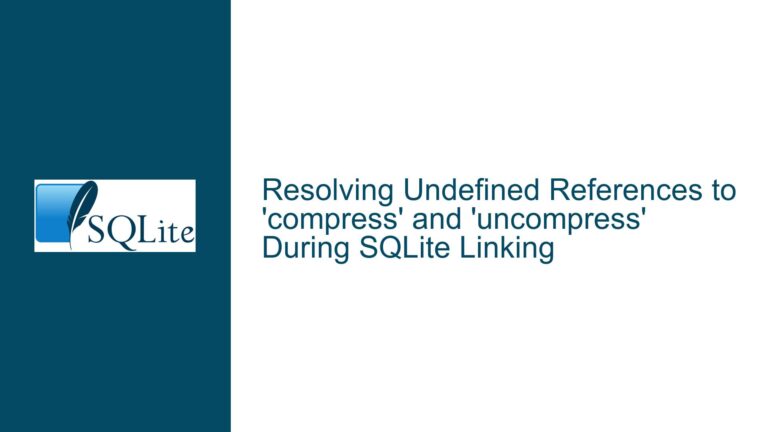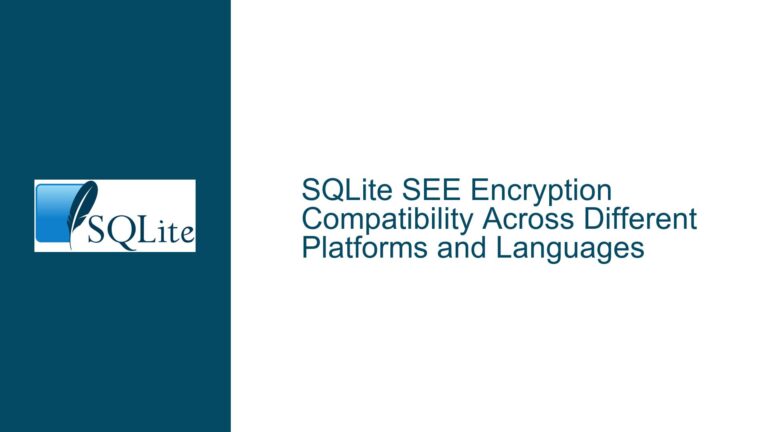Handling Cross-Tab SQLite-Wasm Database Changes in localStorage Environments
Cross-Tab Synchronization Challenges in SQLite-Wasm with localStorage Persistence
The integration of SQLite-Wasm with browser-based storage mechanisms like localStorage introduces unique challenges when coordinating database state across multiple browser tabs or windows. A key use case involves applications requiring real-time synchronization of SQLite data modifications made in one tab to other active tabs sharing the same localStorage-backed database. The sqlite3_js_kvvfs (key-value virtual file system) driver enables SQLite-Wasm to interface with localStorage/sessionStorage, but its transactional model (specifically journal_mode=DELETE) complicates cross-tab change detection. When a transaction commits, the journal file (kvvfs-local-jrnl) is deleted, which can be observed via the storage event. However, relying on hardcoded internal VFS key names like kvvfs-local-jrnl creates fragility, as applications become coupled to implementation details of the sqlite3_js_kvvfs driver. This coupling risks breakage if internal key naming conventions change, despite assurances from maintainers about their stability. The problem is compounded by the synchronous nature of SQLite’s VFS API and the asynchronous reality of browser storage events, requiring developers to bridge these paradigms without sacrificing reliability or performance.
Structural and Architectural Constraints Impacting Synchronization
1. Dependency on VFS-Specific Key Naming Conventions
The sqlite3_js_kvvfs driver maps SQLite’s file operations to key-value storage by prefixing database and journal files with predictable strings. For example, a database named local uses kvvfs-local for its main storage and kvvfs-local-jrnl for its journal. While these prefixes are unlikely to change due to backward compatibility concerns, their use in application code violates encapsulation principles. Applications monitoring localStorage for changes tied to these keys implicitly depend on the VFS’s internal implementation, creating technical debt. This dependency becomes critical when considering alternative VFS implementations or future updates to the sqlite3_js_kvvfs driver that might alter key generation logic, even if such changes are deemed improbable.
2. Transactional Semantics and Journal File Deletion as a Synchronization Signal
SQLite’s journal_mode=DELETE ensures that after a transaction commits, the journal file is removed. In the context of sqlite3_js_kvvfs, this deletion triggers a storage event in other tabs, which can be intercepted to detect commits. However, this approach conflates the journal’s lifecycle with the broader concept of "database modification." For instance, a transaction might modify multiple tables, but the only observable signal is the journal’s deletion. This creates ambiguity: the event indicates that a commit occurred but provides no details about what changed. Applications must therefore reload the entire database state or implement diffing mechanisms, both of which are inefficient for large datasets.
3. Synchronous VFS API vs. Asynchronous Browser APIs
SQLite’s VFS operations are synchronous, but browser storage events (like window.onstorage) and modern synchronization primitives (like BroadcastChannel) are asynchronous. This mismatch complicates transaction coordination. For example, if Tab A commits a transaction and Tab B receives a storage event, Tab B must reload data from localStorage—a synchronous operation—without blocking the browser’s main thread. Additionally, race conditions can arise if multiple tabs attempt simultaneous writes, as localStorage lacks built-in locking mechanisms beyond the JavaScript single-threaded execution model. The Web Locks API offers asynchronous coordination but cannot be directly integrated into the VFS layer due to its synchronous expectations, pushing locking responsibilities to application code.
4. Event-Driven Paradigms and Their Limitations
Relying on window.onstorage events introduces subtle edge cases. These events fire only when a different tab modifies localStorage, not for changes within the same tab. Thus, a tab’s own commits won’t trigger its own storage handler, necessitating redundant update logic. Furthermore, storage events are not guaranteed to fire in the same order as commits across tabs due to network delays or browser throttling. Applications must therefore tolerate eventual consistency or implement additional sequencing mechanisms, increasing complexity.
Strategies for Reliable Cross-Tab Synchronization
Transitioning from Storage Events to BroadcastChannel for Application-Level Coordination
The BroadcastChannel API provides a direct communication channel between browsing contexts (tabs, windows) sharing the same origin. Unlike storage events, which are global and limited to key-value changes, BroadcastChannel allows targeted messaging with structured data. Migrating to this API decouples synchronization logic from VFS internals and provides finer control over update notifications.
Implementation Steps:
Create a BroadcastChannel Instance:
const dbChannel = new BroadcastChannel('sqlite_db_updates');All tabs using the database should instantiate a channel with the same name.
Post Messages on Commit:
After successfully committing a transaction, the active tab broadcasts a message:function onCommit() { dbChannel.postMessage({ type: 'commit', timestamp: Date.now() }); }This replaces the reliance on observing
kvvfs-local-jrnldeletion.Handle Incoming Messages:
Tabs listen for messages and trigger database reloads or UI updates:dbChannel.onmessage = (event) => { if (event.data.type === 'commit') { reloadDatabase(); } };
Advantages:
- Decoupling from VFS Internals: The application no longer depends on sqlite3_js_kvvfs key names.
- Structured Metadata: Messages can include timestamps, transaction IDs, or changed record hints, enabling partial updates.
- Same-Tab Notifications:
BroadcastChannelmessages are received by all tabs, including the sender, simplifying logic.
Browser Compatibility Considerations:
BroadcastChannel is supported in modern browsers but unavailable in legacy environments like Internet Explorer. For compatibility with older browsers, a fallback to localStorage events can be implemented using a synthetic key (e.g., app_db_commit). However, this reintroduces key-based coupling at the application level, albeit with controlled, self-managed keys.
Enhancing the sqlite3_js_kvvfs Driver with Custom Events
While BroadcastChannel addresses application-level coordination, enhancing the sqlite3_js_kvvfs driver to emit custom events during critical operations (e.g., journal deletion) could provide a lower-level synchronization primitive. This would involve modifying the VFS implementation to dispatch events when journal files are created or deleted, allowing applications to listen for these without hardcoding keys.
Proposed API Extension:
sqlite3_js_kvvfs_register_event_handler((event) => {
if (event.type === 'journal_deleted') {
handleCommit();
}
});
Event Structure:
{
target: 'local', // Name of the database
operation: 'journal_delete', // VFS operation type
key: 'kvvfs-local-jrnl' // Affected storage key
}
Benefits:
- Stable Interface: Applications rely on documented event types rather than key names.
- Richer Context: Events could include transaction metadata if the VFS tracks it.
Challenges:
- Maintenance Overhead: Requires extending the sqlite3_js_kvvfs driver and maintaining backward compatibility.
- Performance Impact: Frequent event dispatching might affect transaction throughput.
Leveraging Web Locks for Write Coordination
The Web Locks API allows asynchronous acquisition of locks, enabling tabs to coordinate write access. While SQLite’s VFS operates synchronously, applications can wrap transactions with lock acquisition to prevent concurrent writes.
Integration Example:
async function executeTransaction(callback) {
await navigator.locks.request('db_write_lock', async () => {
const db = new SQLiteDatabase();
await db.open();
callback(db);
await db.close();
});
}
Considerations:
- Async/Sync Mismatch: SQLite-Wasm operations are synchronous, so locks must be acquired before entering transactional code.
- Deadlock Risks: Improper lock sequencing across tabs can lead to deadlocks.
- Scope: Locks are scoped to the origin, aligning with localStorage’s security model.
Hybrid Approach: Combining BroadcastChannel and Web Locks
For robust synchronization, combine BroadcastChannel for notifications and Web Locks for write coordination:
- Acquire a Lock before writing.
- Commit Changes and broadcast a message.
- Release the Lock after confirmation.
This ensures only one tab modifies the database at a time, while others reload upon receiving notifications.
Mitigating Hardcoded Key Risks in Existing Implementations
If migrating to BroadcastChannel is impractical, mitigate key dependency risks by:
- Encapsulating Key References: Centralize key names in configuration objects:
const DB_KEYS = { main: 'kvvfs-local', journal: 'kvvfs-local-jrnl' }; - Validating Key Stability: Monitor SQLite-Wasm release notes for changes to sqlite3_js_kvvfs key generation logic.
- Feature Detection: Check for the presence of expected keys during initialization to fail early if VFS internals change.
Conclusion
Cross-tab synchronization in SQLite-Wasm applications using localStorage demands careful consideration of browser APIs, VFS internals, and transactional semantics. Migrating from storage events to BroadcastChannel reduces brittleness by decoupling from implementation details, while Web Locks provide coordination primitives for write contention. Future enhancements to the sqlite3_js_kvvfs driver, such as custom events, could further streamline synchronization, but application-level strategies currently offer the most robust and maintainable solutions. Developers should prioritize encapsulation, test under heavy concurrency, and monitor evolving browser standards to adapt their synchronization mechanisms as new APIs emerge.






